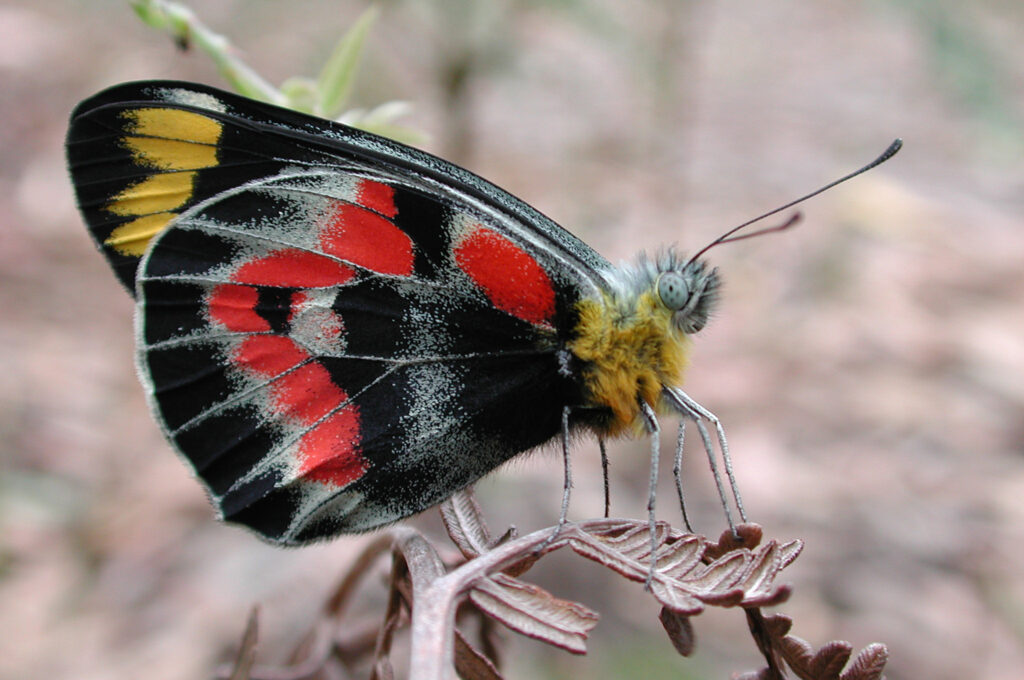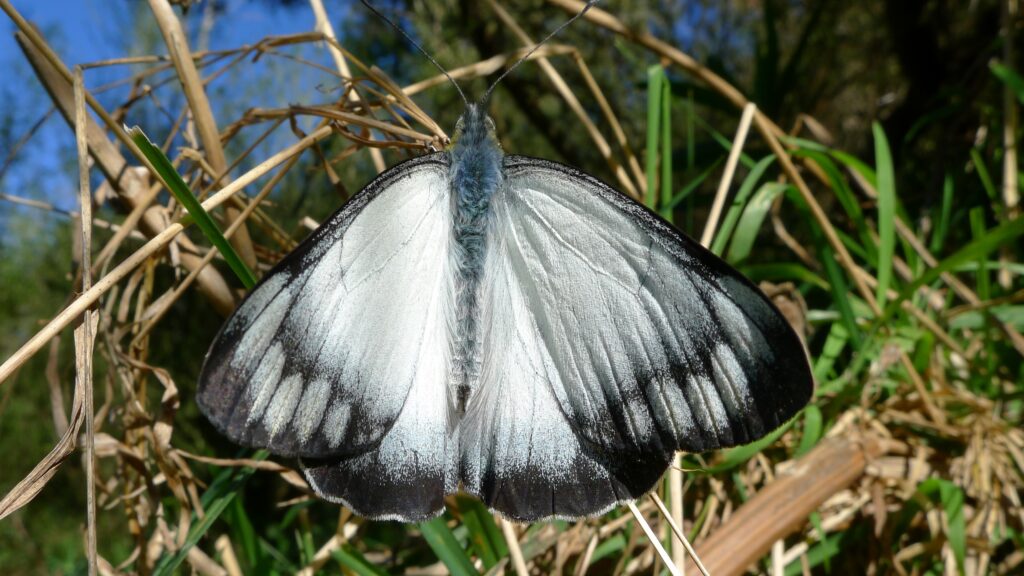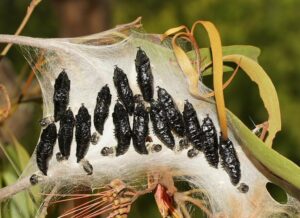This year I have been delighted to see Imperial Jezebel butterflies visiting our garden! These large and graceful butterflies are white and edged in black and grey when their wings are open and flat. When they alight on a flower to feed, their wings are held together and upright, and you can see their long black clubbed antennae, cute furry yellow body and wings with a striking chequered pattern of bright red, yellow, white and black.

Such vivid colours! by Neil Hamilton Mansfield via CC
I have spotted a few of these butterflies here and there in previous years but this is the first time I have seen them in such numbers and sticking around for so long. There are often about four fluttering about slowly – usually near our very large Abelia shrub.
Everyone has been talking about this summer’s huge numbers of Cabbage White Butterflies, an introduced species that feeds mainly on introduced plants from the Brassica family. The mild winter, and very wet, early summer led to the Cabbage Butterfly boom, and may also be the reason for an increase in numbers of other species.

The white/ black / grey of the butterfly inspires their other common name – Imperial White. By John Tann via CC.
Unlike Cabbage Whites, Imperial Jezebels (Delia harpalyce) are very much a native species. The young feed on mistletoe plants which parasitise eucalypts, and to a lesser extent Acacias. The word “parasite” has such negative connotations. However, mistletoe plants are an essential part of our forests – their leaves are chock full of nutrients and their dense ball shape a perfect home for animals as varied as spiders, small birds and possums. Mistletoe flowers are a source of nectar for butterflies and birds, and their berries are eaten by possums and of course Mistletoebirds. Mistletoebirds are tiny black, white and red birds that feed on the sticky fruit then “plant” new mistletoe by wiping their rear end on a branch to remove the very sticky seed!
Imperial Jezebels lay their bright yellow eggs on the leaves of mistletoes. In a 1992 study near Melbourne adult butterflies selected Box Mistletoe Amyema miquelii, Drooping Mistletoe A pendulum and Creeping Mistletoe Meullerina eucalyptoides in equal frequency. After hatching, the young caterpillars munch their way into a larger fat caterpillar stage which is quite hairy and resembles sawfly or spitfire larvae. When it is time to pupate, the caterpillars build a dense web and shelter in the web until emergence. What a sight that would be – to see the new adults emerging simultaneously!

Imperial Jezebel pupa by iNaturalist Australia legend Reiner
These large butterflies are bivoltine – yes a new word for me too – meaning that they have two broods a year. In the study mentioned above, Michael F Braby, butterfly enthusiast and Associate Professor of Entomology at ANU suggests that they have a nifty way of coping with life in the cool climate of Victoria. The pupae in August are black in colour, and their webs are large and positioned facing north, northwest in the mistletoe clump so the developing butterflies can catch some winter sun. Conversely, the December pupae are orange in colour, with smaller webs, and often located in the shady part of the clump.
Keen to hear more about the cabbage whites? Here’s me talking to Jonno and Gav on ABC Statewide. I am stoked to say this Backyard Critters segment is now fortnightly! Every second Tuesday at about 10:40, 10:50 am.
Thanks to Gavin McGrath for sending through this audio.
Finally, for a cool activity on these hot days – a colouring in activity for the young or young at heart: https://www.bushheritage.org.au/getmedia/830e4b14-7bae-44d7-b99f-7a424fd2f278/I-imperial-butterfly
A shorter version of this article was published in the Wombat Post https://thewombatpost.com.au/2024/03/08/nature-diary-imperial-jezebel-butterflies/
Hello Tanya,
I really enjoyed your article. I was very interested in the different pupae colour and orientation of the web with the seasons. A couple of years ago, I made a study of imperial jezebel caterpillars and pupae in a local reserve. The butterflies emerged from their pupae in October. When they first created their pupae, they were brilliant orange, changing over a few days to red, then black. I was fortunate enough to be in the right place at the right time, and watched a butterfly emerging from its pupa. It was quite an effort to haul itself out. It had a fat body and shrunken wings. Over a few minutes, the wings expanded and the body became thinner. I recorded this on a phone camera, and also wrote an article about my study for my local newsletter. I would be happy to share one or both with you, if you are interested.
Hi Wendy! Both would be great thanks! Thanks for reading 🙂 I will email you!
Stunning photos. Interesting how different the top and bottom sides of the wings are.
That’s very kind of you, thanks Christine – thanks to Wikimedia commons for the images – I am a writer more than a photographer 🙂
Thanks Tanya, always an interesting read.
Charlie
Aw that’s very kind of you Charlie!